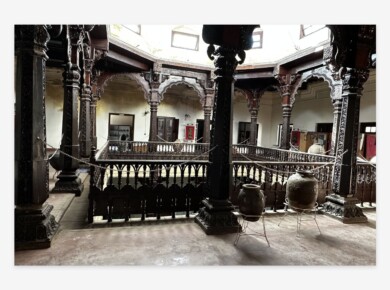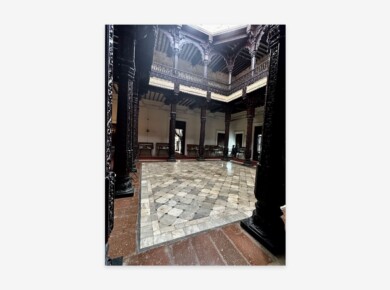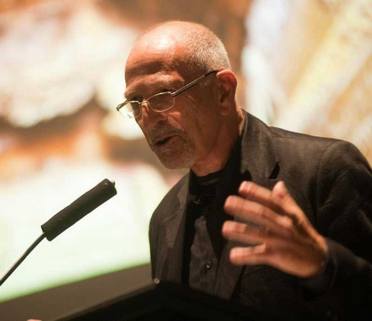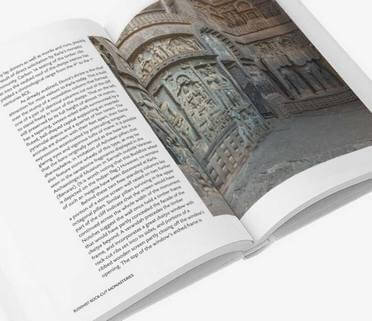Jayalakshmi Vilas Mansion (Mysuru, Karnataka)
The DHF is restoring the Jayalakshmi Vilas Mansion building, as well as cataloguing and conserving its rich ethnographic collections
The Deccan Heritage Foundation (DHF) has secured a landmark five-year grant from the Harish & Bina Shah Foundation (HBSF) for the conservation of the Jayalakshmi Vilas Mansion on the campus of the University of Mysore (UoM). This mansion dates to 1901, when construction began on what was to be the residence of Jayalakshmi, sister of the Wadiyar ruler Krishnaraja IV. DHF India, UoM and HBSF formally launched the project by signing a tripartite agreement on January 4th 2024. The project is also being partly funded by the prestigious Ambassadors Fund for Cultural Preservation (AFCP), a program established by the US Congress to assist countries in preserving museum collections, ancient and historic sites, and traditional forms of expression.
Jayalakshmi Vilas remained a royal residence until the 1950s, after which it was incorporated into the adjacent campus of the University of Mysore, which used it to house their Department of Archaeology and Anthropology. Funding from the Infosys foundation aided in the restoration and curation of objects in the ground floors of the mansion and two wings. In 2001, the mansion opened its doors to visitors as the city’s Folklore Museum. The Museum currently houses one of the most important collections of folkloric and ethnographic artefacts in Karnataka.
With its symmetrical plan, and part-circular arcades of Ionic and Corinthian columns, Jayalakshmi Vilas is one of the outstanding examples of the Classical European style adopted by Mysore architects. Interior apartments are arranged around two internal courtyards: one is roofed with a stained-glass dome that recalls a similar ceiling in the great palace in the middle of Mysuru. The mansion also preserves marble floors and ornate wooden columns. There was once an ornamental garden in front.
Time has taken its toll on Jayalakshmi Vilas. The roof over the west wing has partly collapsed and other portions of the mansion are now judged structurally unsafe. The grants from HBSF and AFCP will support the DHF in restoring and refurbishing the building. They will also fund the cataloguing and conservation of the rich anthropological and ethnographic collections, comprising thousands of artefacts, as well as the unique assemblage of manuscripts, documents and memorabilia linked with prominent figures of Kannada literature. Once the conservation of the collection is completed, the funding will help in the creation of an ethnographic museum that is contemporary and inclusive.
The DHF’s Conservation Management Plan will focus on sustainability of resources for the operation and maintenance of the building and its collections. A core objective of DHF’s JLV project is to demonstrate that an academic institution like the University of Mysore, located in a historic city like Mysuru, can develop a sustainable model of heritage management by institutionalising historic building maintenance and management. Building an in-house capacity within the University will be accomplished by:
- dovetailing various academic activities into heritage management
- preserving ethnographic collections in the museum and in other public and private collections in the community
- developing an infrastructure that will favour visitor access
- promoting partnerships with both Indian and overseas museums to assist scholars and curators in interpreting the collections.
Details

Project Status
Ongoing

Location
Mysuru, Karnataka

Partners
University of Mysore
The US Consulate General in Chennai, through the Ambassador's Fund for Cultural Preservation (AFCP)
Harish & Bina Shah Foundation (HBSF)

Environment
The DHF’s Conservation Management Plan will focus on sustainability of resources for the operation and maintenance of the building and its collections.

Community
It will develop an infrastructure that will favour visitor access and promote partnerships with both Indian and overseas museums to assist scholars and curators in interpreting the collections.

Support Overview
The HBSF and AFCP grant will support the restoration and refurbishment of the building. It will also help fund the conservation of the thousands of artefacts, as well as the unique assemblage of manuscripts, documents and memorabilia linked with prominent figures of Kannada literature, in addition to developing an infrastructure that will favour visitor access























